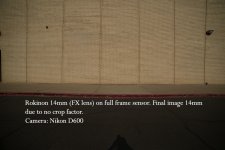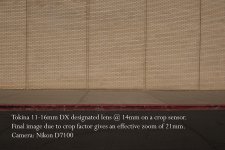Horoscope Fish
Senior Member
Why, exactly, do you seem think I am not understanding this point?The 'naming convention' of full-frame lenses has been the same since the F-mount was invented in 1959. No designation = full-frame.
...
Why, exactly, do you seem think I am not understanding this point?The 'naming convention' of full-frame lenses has been the same since the F-mount was invented in 1959. No designation = full-frame.
This from my DX D3200
View attachment 102883
One lens with two focal lengths. It's no wonder people are confused.
That is very poorly worded in your Exif tool.
A lens only has one focal length (OK, one at any one zoom setting).
Your data says Focal Length 105mm. Which is also what the lens surely reports.
What it says is 35mm focal length 157mm can only mean another lens on another camera (of FX format) would use a 157mm lens to see the same view as the 105mm is seen in your camera. It is about the scene your sensor shows. IT DOES NOT SAY YOUR LENS IS EVER 157mm. It says your lens is 105mm.
The ONLY importance of this comparison is to set a standard to compare the expected field of view on various cameras. Many of us have used 35mm film for years (before digital), and many of us know exactly what to expect a 105mm lens will show (in that frame of reference). All these various little digital sensors though, who knows now? So equivalent 35mm focal length is telling us that on this camera, with this cropped sensor, the 105 mm lens will produce a view comparable to 157 mm on 35 mm film.
That tells many of us a lot. It tells newbies nothing.
You missed the point.
Sorry, but it is you that does not get it yet.
A 14 mm lens has a 14mm field of view, always, no exceptions.
It is just the smaller DX sensor (cropped sensor) that cannot see it all of its wider view.
This is absolutely no fault (or property) of the lens, which is always 14mm.
The effect is simply and only due to the smaller camera sensor, cropping away some of what the lens otherwise sees. Blame the sensor, it is stupid to blame the lens.


I too always wondered why a DX specific lens wasn't made to accurately reflect the measurement of the lens relative to a DX camera sensor.
I do completely understand it. The point of this thread was to show what the real world outcome is for those not understanding what the final outcome will be due to the crop factor.
Of course the lens would technically be a 9mm lens,
Maybe so, hopefully so, but if so, you might choose your words better. The lens never changes its one focal length. That is simply impossible.
No, there is a not an actual zoom happening. The smaller sensor area is taking a smaller slice of the image coming through the lens. This smaller slice is what makes a 50mm lens on a crop sensor have an effective zoom range of 76mm.
If someone is not familiar with what a 150mm lens does on 35mm film format, then it is pointless for them to know that their 105 mm on DX works like 157 mm on FX.
Why, exactly, do you seem think I am not understanding this point?
...
Nice dodge...Why, exactly, do you think an FX lens need to have the letters FX emblazoned on it?
........
Now answer *my* question.
...
No, you haven't. You've just repeated the same ideas.I have. It appears you cannot accept it, however.
Hmmm... No trolling in this thread. Sorry you feel being held accountable for your responses amounts to trolling.I am, however, done with this thread as it has turned into nothing but trolling.
Ever notice how Nikon lables FX camera's with an FX badge... Yeah... Huh... I wonder why that is.
Why, exactly, do you think an FX lens need to have the letters FX emblazoned on it?

